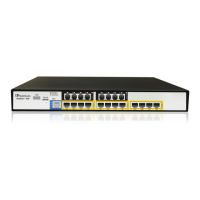Version 6.6 627 Mediant 800 MSBR
User's Manual 50. Software Upgrade
50 Software Upgrade
The Software Update menu allows you to do the following:
Load Auxiliary files (see 'Loading Auxiliary Files' on page 627)
Load a Software License Key (see 'Software License Key' on page 644)
Upgrade the device using the Software Upgrade Wizard (see 'Software Upgrade
Wizard' on page
648)
Load/save a Configuration file (see 'Backing Up and Loading Configuration File' on
page
651)
50.1 Loading Auxiliary Files
Various Auxiliary files can be installed on the device. These Auxiliary files provide the
device with additional configuration settings. The table below lists the different types of
Auxiliary files:
Auxiliary Files
File Description
INI Configures the device. The Web interface enables practically full device
provisioning. Howe
ver, some features may only be configured by ini file or you
may wish to configure your device using the ini file. For more information on
using the ini file to configure the device, see 'INI File-Based Management' on
page
95.
CAS CAS auxiliary files containing the CAS Protocol definitions for CAS-terminated
trunks (for various types of CAS signaling). You can use the supplied files or
construct your own files. Up to eight different CAS files can be installed on the
device. For more information, see CAS Files on page 633.
Call Progress
Tones
Region-specific, telephone exchange-dependent file that contains the Call
Progress Tones (CPT) levels and frequencies for the device. The default CPT
file is U.S.A. For more information, see 'Call Progress Tones File' on page
629.
Dial Plan Provides dialing plans, for example, to know when to stop collecting dialed
digits and start forwarding them or for obtaining the destination IP address for
outbound IP routing. For more information, see 'Dial Plan File' on page 633.
User Info The User Information file maps PBX extensions to IP numbers. This file can
be used to represent PBX extensions as IP phones in the global 'IP world'. For
more information, see 'User Information File' on page 639.
The Auxiliary files can be loaded to the device using one of the following methods:
TFTP: This is done by specifying the name of the Auxiliary file in an ini file (see
Auxiliary and Configuration Files Parameters) and then loading the ini file to the
device. The Auxiliary files listed in the ini file are then automatically loaded through
TFTP during device startup. If the ini file does not contain a specific auxiliary file type,
the device uses the last auxiliary file of that type that was stored on its non-volatile
memory.

